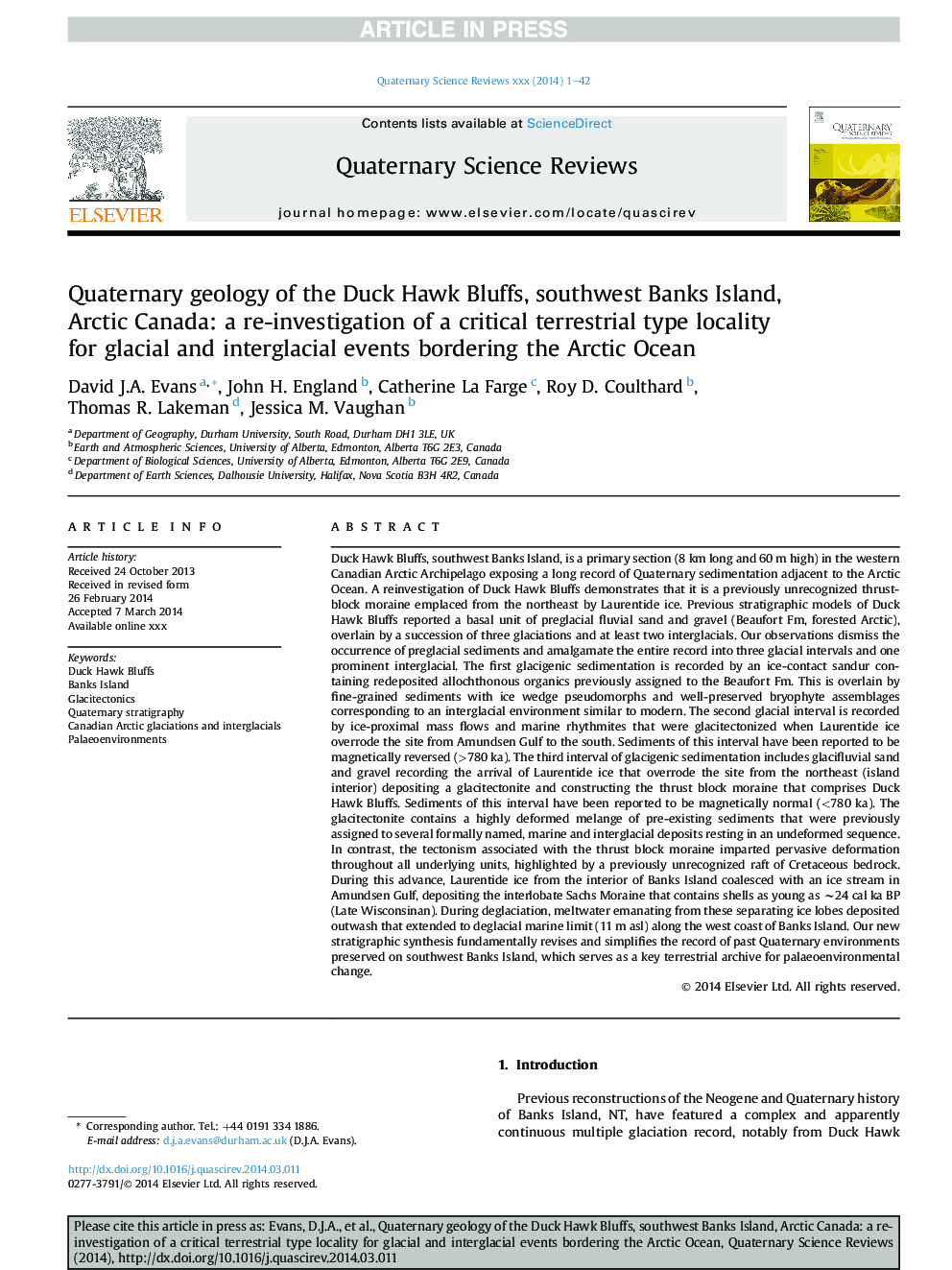| کد مقاله | کد نشریه | سال انتشار | مقاله انگلیسی | نسخه تمام متن |
|---|---|---|---|---|
| 6445595 | 1640843 | 2014 | 42 صفحه PDF | دانلود رایگان |
عنوان انگلیسی مقاله ISI
Quaternary geology of the Duck Hawk Bluffs, southwest Banks Island, Arctic Canada: a re-investigation of a critical terrestrial type locality for glacial and interglacial events bordering the Arctic Ocean
دانلود مقاله + سفارش ترجمه
دانلود مقاله ISI انگلیسی
رایگان برای ایرانیان
موضوعات مرتبط
مهندسی و علوم پایه
علوم زمین و سیارات
زمین شناسی
پیش نمایش صفحه اول مقاله

چکیده انگلیسی
Duck Hawk Bluffs, southwest Banks Island, is a primary section (8 km long and 60 m high) in the western Canadian Arctic Archipelago exposing a long record of Quaternary sedimentation adjacent to the Arctic Ocean. A reinvestigation of Duck Hawk Bluffs demonstrates that it is a previously unrecognized thrust-block moraine emplaced from the northeast by Laurentide ice. Previous stratigraphic models of Duck Hawk Bluffs reported a basal unit of preglacial fluvial sand and gravel (Beaufort Fm, forested Arctic), overlain by a succession of three glaciations and at least two interglacials. Our observations dismiss the occurrence of preglacial sediments and amalgamate the entire record into three glacial intervals and one prominent interglacial. The first glacigenic sedimentation is recorded by an ice-contact sandur containing redeposited allochthonous organics previously assigned to the Beaufort Fm. This is overlain by fine-grained sediments with ice wedge pseudomorphs and well-preserved bryophyte assemblages corresponding to an interglacial environment similar to modern. The second glacial interval is recorded by ice-proximal mass flows and marine rhythmites that were glacitectonized when Laurentide ice overrode the site from Amundsen Gulf to the south. Sediments of this interval have been reported to be magnetically reversed (>780 ka). The third interval of glacigenic sedimentation includes glacifluvial sand and gravel recording the arrival of Laurentide ice that overrode the site from the northeast (island interior) depositing a glacitectonite and constructing the thrust block moraine that comprises Duck Hawk Bluffs. Sediments of this interval have been reported to be magnetically normal (<780 ka). The glacitectonite contains a highly deformed melange of pre-existing sediments that were previously assigned to several formally named, marine and interglacial deposits resting in an undeformed sequence. In contrast, the tectonism associated with the thrust block moraine imparted pervasive deformation throughout all underlying units, highlighted by a previously unrecognized raft of Cretaceous bedrock. During this advance, Laurentide ice from the interior of Banks Island coalesced with an ice stream in Amundsen Gulf, depositing the interlobate Sachs Moraine that contains shells as young as â¼24 cal ka BP (Late Wisconsinan). During deglaciation, meltwater emanating from these separating ice lobes deposited outwash that extended to deglacial marine limit (11 m asl) along the west coast of Banks Island. Our new stratigraphic synthesis fundamentally revises and simplifies the record of past Quaternary environments preserved on southwest Banks Island, which serves as a key terrestrial archive for palaeoenvironmental change.
ناشر
Database: Elsevier - ScienceDirect (ساینس دایرکت)
Journal: Quaternary Science Reviews - Volume 91, 1 May 2014, Pages 82-123
Journal: Quaternary Science Reviews - Volume 91, 1 May 2014, Pages 82-123
نویسندگان
David J.A. Evans, John H. England, Catherine La Farge, Roy D. Coulthard, Thomas R. Lakeman, Jessica M. Vaughan,